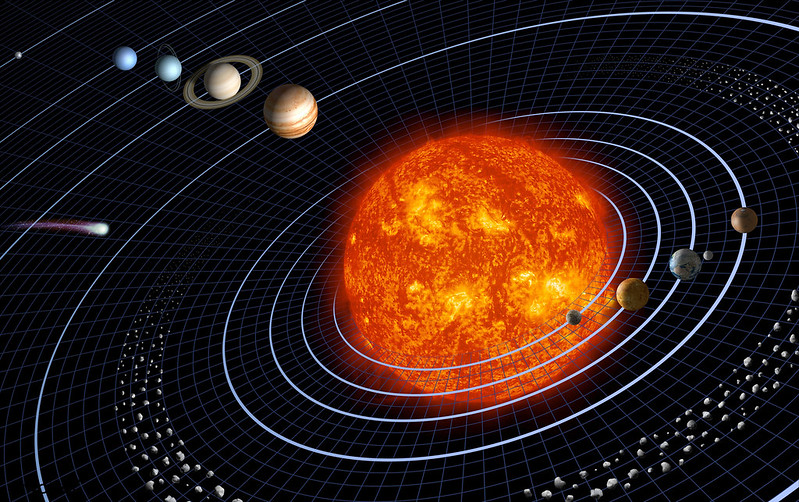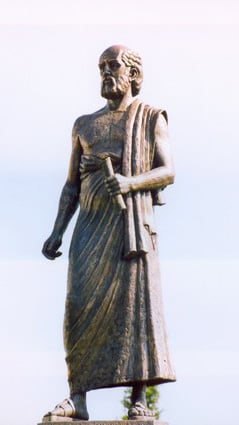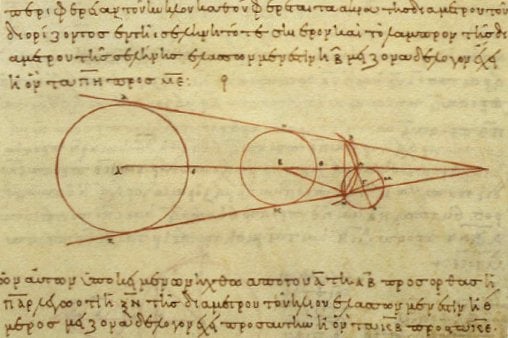
Despite being attributed to Copernicus, the Ancient Greek astronomer Aristarchus of Samos was the first who presented the Heliocentric system, maintaining that the Earth revolves around the Sun.
The sages of antiquity were divided between the advocates of the geocentric theory of the world and those of the heliocentric theory. In other words, the former believed the Sun rotates around the Earth, and the latter that the Earth rotates around the Sun.
The former, who had placed the Earth as the center of the universe, were the vast majority, while the latter were the minority. Aristarchus, a firm believer of the heliocentric system was doubted by most astronomers and physicists of his time.
His astronomical ideas were often rejected in favor of the far more popular geocentric theories of Aristotle and Ptolemy.
Aristarchus’ work on the motion of the Earth has not being saved, except for one surviving text: “Treatise on the Sizes and Distances of the Sun and Moon.”
Yet, his brilliant theories have been referenced by Greek mathematician Archimedes, Greek biographer Plutarch, and Greek philosopher Sextus Empiricus.
The Greek astronomer’s theory regarding the Sun as being at the center of the solar system, posits that the stars are just other bodies similar to the Sun.

Ancient Greeks and the Cosmos
During the 6th century BC, a new theory was developed in Ionia, according to which the universe around us can be understood because it has an internal order; hence, its functions can be read.
Nature is not unpredictable because there are rules followed by various natural processes. This order of the universe was admired by Ancient Greek philosophers who named the universe “Cosmos,” which means “ornament” or “adornment.”
Ionian philosophers such as Thales introduced the idea that in the Cosmos there are principles, forces, and natural laws that can be understood, so there is no longer the need to interpret phenomena as acts of the gods.
Natural phenomena such as thunderstorms or earthquakes could be understood as acts of nature, not as acts of Zeus or other gods.
Based on the new thinking introduced by the Ionian philosophers, Aristarchus worked on his theories and calculations to reach his Heliocentric system. He was also influenced by the the concept presented by Philolaus of Croton (c. 470 – 385 BCE) of a fire at the center of the universe, but Aristarchus identified the “central fire” with the Sun and he put the other planets in their correct order of distance around the Sun.
Aristarchus: The Greek Pioneer of the Heliocentric System
The contribution of the Ionian philosophers to the formation of modern astronomical and cosmological science is decisive.
The pioneer was Aristarchus of Samos (c. 310-230BC), an astronomer, mathematician and geometer of the Alexandrian School and founder of the radical, for his time, heliocentric theory.
According to this theory, the apparent movement of a planet is cyclical, as observed from Earth. It is periodically correct, i.e. the planet appears to move in the same direction and then counterclockwise.
The Greek astronomer understood that the Moon casts no light but shines by reflection of the Sun’s light. He believed that if one measured the angle between the Sun and Moon when the Moon is half-illuminated (said angle suggested by the illumination itself), one could calculate their distances.
Using his invention, the “skafion,” a type of sundial, Aristarchus determined the angle was 87 degrees. Nowadays, it is believed it is 89 degrees. His further calculations were that the Sun was twenty times further away from the Earth than the Moon. It is actually four hundred times further away.

Aristarchus’ Achievements
Through his inquiries into the distance of the Sun and Moon from the Earth, it made more sense to him that the Sun is at the center of the other planets.
Aristarchus’ extraordinary ability to understand the celestial phenomena led the Ancient Greek astronomer to the theory of the heliocentric system.
Using the skafion, he was able to determine the exact time of the correct midday in a certain place (and to define time, in general, within the daylight span).
He was also able to determine the latitude of the place, the value of obliquity of the ecliptic orbit, the Sun’s daily deviation, and the days of equinoxes and solstices of the year 281 BC.
Overall, Aristarchus is considered among the first who defined the daily rotation of the celestial sphere as a direct result of Earth’s axial rotation.
He also explained the sequence of seasons as a result of the inclination of Earth’s axis of rotation in relation to the ecliptic level. He is the first Greek astronomer who gave the most accurate value of the apparent diameter of both the Sun and Moon.

Aristarchus’ Work Recognized Centuries Later
Greek astronomer Aristarchus’ heliocentric theory was not recognized in his time. Great ancient scientists and philosophers, such as Pythagoras, Aristotle, and Ptolemy, were strong supporters of the geocentric theory.
The Ionian astronomer’s theory was forgotten for centuries. Yet, along with the Renaissance came the recognition of his great work.
In 1543, almost two thousand years after Aristarchus, his theory was vindicated by the famous Polish astronomer Nicolaus Copernicus. All Copernicus did was to simply bring back into light the heliocentric theory.
By utilizing the brilliant ideas of the Ancient Greek astronomer, nowadays, Copernicus is considered to be the astronomer who actually introduced the heliocentric theory.
Still, the heliocentric model was not widely accepted until it was mathematically proven by Sir Isaac Newton (1642-1727) and Aristarchus’ conclusions were validated.
See all the latest news from Greece and the world at Greekreporter.com. Contact our newsroom to report an update or send your story, photos and videos. Follow GR on Google News and subscribe here to our daily email!



